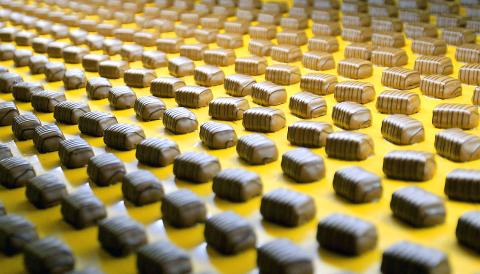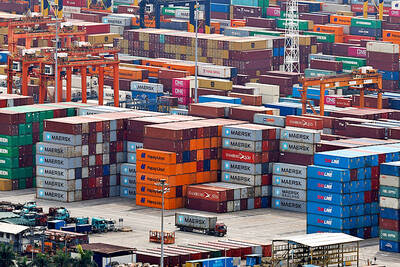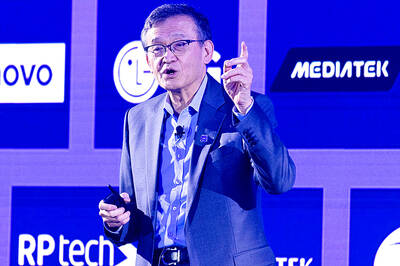Belgian chocolate makers believe their renowned pralines should have similar protection to that enjoyed by French champagne or Italy’s Parma ham.
They want the term “Belgian chocolate” to be their exclusive preserve and also want to crack down on foreign rivals dressing up their products as “Belgian style.”
They say copycats eat into sales and undermine a stamp of quality built up since 1912, when Jean Neuhaus invented the hard-shelled, cream-filled chocolate praline.

Photo: Reuters
The indsutrty federation will meet regional governments next month to decide how Belgium might apply to the EU to protect Belgian chocolates or perhaps seek a trademark to safeguard them.
“What makes us sad is that very often the copies are not up to the standard of the originals,” Neuhaus chief executive Jos Linkens told reporters in an interview.
“If top chocolatiers around the world copied us, perhaps we would be happy. We don’t want the image of quality to suffer,” said Linkens, who also heads Choprabisco, the Belgian biscuit, chocolate and confectionery federation.
Belgium is proud of its chocolate. It boasts more than 200 chocolate firms, as well as more than 2,000 chocolate stores and museums, tours and workshops.Despite their quality, like other luxury items, sales of Belgian chocolates have stagnated or slipped in mature Europe and North American markets, but seen roaring growth in emerging markets.
Overall exports of Belgian pralines rose just 1 percent between 2007 and 2011, but grew 60 percent in Asia and 82 percent in Africa.
Sales to Asia in 2011 were three times higher than a decade earlier. Individual chocolate makers talk of expansion in China and India last year of up to 50 percent.
There is yet more scope for growth, with the average Chinese person eating less than 100g of chocolate per year compared with the between 6kg and 10kg consumed by Europeans, Linkens said.
The surging demand in new markets has left foreign producers eager for a share, tempting some to claim they too make Belgian chocolates.
Choprabisco secretary-general Guy Gallet has a crate of “Belgian chocolate” boxes he and traveling Belgian executives found on their travels, which include examples from Canada, China and Hungary.
Switzerland, famous for its milk chocolate, has been more active in its protection of domestic brands.
Swiss chocolate has also seen sharp growth in Asia, with sales in China last year rising by 49 percent and by 52 percent in India.
However, Chocosuisse, the federation of Swiss chocolate makers, has trademarked the terms “Swiss” and “Switzerland” in the EU, the US and Canada, and it works to enforce those rights.
The federation has staff dedicated to the problem and can spend up to 80,000 Swiss francs (US$85,100) a year on lawyers’ fees.
Steven Candries, export manager at Belgium’s Guylian chocolate company, said the firm has been battling a Chinese maker of “Belgian chocolates” with a box design remarkably similar to Guylian’s.
“If everyone starts using the term, then what is the value? Nothing,” he said.
He and others in Belgium, whose chocolate brings in almost 4 billion euros (US$5.2 billion) each year, believe that securing the EU’s protected geographical status or a trademark would curb imposters and set Belgian chocolate apart.
Gallet said that it was hard to imagine Belgian chocolate being accorded such status, until now.
Unlike earlier protected products, the chocolate itself does not come from Belgium, with the vast majority of cocoa beans originating in Ivory Coast and Ghana.
Recently, the EU included “chocolate and derived products” as a specific category worthy of protection and this year, it modified its rule to say that a geographical indication could apply to products from a specific country.
Neuhaus’ Linkens believes it will happen, although could take some time.
The WTO is supposed to uphold protection of geographical indications, such as Colombian coffee, but can choose how to do so.
The EU’s recent bilateral trade deals, such as with South Korea and Colombia, have proven a stronger way to ensure mutual respect of protected products.
However, what counts as “Belgian chocolate” is open to debate.
Gallet says a problem is that in some cases the chocolate itself is from a Belgian facility of one of the bulk producers.
“That shouldn’t count as Belgian chocolate. What you should be saying is: ‘Made with Belgian chocolate,’” he said.
Since 2008, some Belgian producers have signed up to a non-binding chocolate code, specifying that to be labeled as “Belgian chocolate” the products must be refined and molded in Belgium, but even that has its critics, like Belgium-based Godiva Chocolatier.
Godiva has a very strong presence in North America, a market it supplies from a factory in Pennsylvania.
Guillaume de Foucault, Godiva’s general manager for Europe, the Middle East and Africa, said that these Godiva chocolates are still essentially Belgian, in the same way that one might think that a BMW made in South Carolina as still essentially a German car.
“Godiva started in 1926 in Belgium, we have a Belgian chef and Belgian facilities,” he said. “It’s important to include a lot of players. Some have difference areas of expertise. It would be very limiting if only chocolate produced in Belgium could be considered.”

The Eurovision Song Contest has seen a surge in punter interest at the bookmakers, becoming a major betting event, experts said ahead of last night’s giant glamfest in Basel. “Eurovision has quietly become one of the biggest betting events of the year,” said Tomi Huttunen, senior manager of the Online Computer Finland (OCS) betting and casino platform. Betting sites have long been used to gauge which way voters might be leaning ahead of the world’s biggest televised live music event. However, bookmakers highlight a huge increase in engagement in recent years — and this year in particular. “We’ve already passed 2023’s total activity and

Nvidia Corp CEO Jensen Huang (黃仁勳) today announced that his company has selected "Beitou Shilin" in Taipei for its new Taiwan office, called Nvidia Constellation, putting an end to months of speculation. Industry sources have said that the tech giant has been eyeing the Beitou Shilin Science Park as the site of its new overseas headquarters, and speculated that the new headquarters would be built on two plots of land designated as "T17" and "T18," which span 3.89 hectares in the park. "I think it's time for us to reveal one of the largest products we've ever built," Huang said near the

China yesterday announced anti-dumping duties as high as 74.9 percent on imports of polyoxymethylene (POM) copolymers, a type of engineering plastic, from Taiwan, the US, the EU and Japan. The Chinese Ministry of Commerce’s findings conclude a probe launched in May last year, shortly after the US sharply increased tariffs on Chinese electric vehicles, computer chips and other imports. POM copolymers can partially replace metals such as copper and zinc, and have various applications, including in auto parts, electronics and medical equipment, the Chinese ministry has said. In January, it said initial investigations had determined that dumping was taking place, and implemented preliminary

Intel Corp yesterday reinforced its determination to strengthen its partnerships with Taiwan’s ecosystem partners including original-electronic-manufacturing (OEM) companies such as Hon Hai Precision Industry Co (鴻海精密) and chipmaker United Microelectronics Corp (UMC, 聯電). “Tonight marks a new beginning. We renew our new partnership with Taiwan ecosystem,” Intel new chief executive officer Tan Lip-bu (陳立武) said at a dinner with representatives from the company’s local partners, celebrating the 40th anniversary of the US chip giant’s presence in Taiwan. Tan took the reins at Intel six weeks ago aiming to reform the chipmaker and revive its past glory. This is the first time Tan